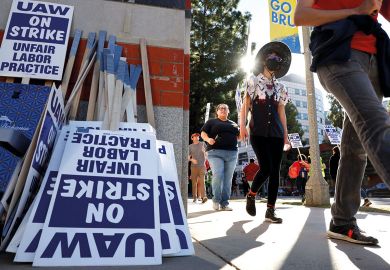Average faculty salaries in the US have fallen sharply for the past three years relative to inflation, fuelling a two decade-high level of higher education labour activism, according to the nation’s main faculty grouping.
The nationwide decline, after adjustments for inflation, totalled an average compensation loss of 7.5 per cent over the three-year period ending this March, the American Association of University Professors (AAUP) calculated.
The AAUP drew its figures from surveys it conducted among nearly 900 US colleges and universities, covering more than 370,000 full-time faculty and 90,000 part-time instructors.
The relative decline in compensation came amid unusually high price inflation – nearly 9 per cent in the US last year – and despite unusually high levels of labour activism. The US last year experienced its largest number of strikes since 2005, with the education sector accounting for 60 per cent of all employees involved, according to Bloomberg data.
The strikes – including the year’s largest in any US sector, a six-week walkout by 48,000 graduate student workers at the University of California system – should be seen primarily as a reflection of the relative loss of pay, said an AAUP spokesman, Kelly Benjamin.
“We’re seeing a new era of union activism in higher ed – and that’s a result of what we’re witnessing” in salaries, Mr Benjamin said. “And it’s a long trajectory that led to this point.”
Yet the AAUP does acknowledge progress. Its annual report last year showed average salaries for full-time US faculty members were up by 2 per cent in the 2021-22 academic year, or a 5 per cent drop when considering inflation. Now it says the average jumped by 4.1 per cent between autumn 2021 and autumn 2022, in the greatest single-year increase since 1990-91. That was equal to a 2.4 per cent decrease when counting inflation, it said.
As at the California system, much of the labour activism in US higher education has involved graduate students and other non-permanent teaching staff. The number of US faculty on contingent appointments declined by 7 per cent from autumn 2019 to autumn 2020, at the start of the Covid pandemic, before regaining about 25 per cent by autumn 2021, the AAUP says. Over those same two periods, it said, graduate student employment declined by 4 per cent and recovered by 90 per cent.
Most part-time faculty members received neither retirement benefits nor medical insurance contributions in the 2020-21 academic year, the AAUP says.
The AAUP’s findings come from a comprehensive annual report it produces on the economic status of the higher education profession. Among many other data points, it showed that average full-time faculty salaries for women were 82 per cent of those for men in the 2022-23 year. At the full-professor rank, the AAUP said, women earned an average salary of $136,490 (£108,210), compared with $156,820 for men.
Median salaries for college and university presidents in the 2022-23 year ranged from around $260,000 at public two-year institutions to $800,000 at private doctoral-granting universities. Median presidential salaries increased by 9.6 per cent, compared with 7.1 per cent for full-time faculty, between autumn 2019 and autumn 2022, the AAUP said.
A separate new report, meanwhile, by the State Higher Education Executive Officers Association (SHEEO) – representing public postsecondary governing boards – showed that US states had been making greater efforts of late to hold down costs for their students.
The SHEEO analysis found that 60 per cent of US states limited or froze tuition increases at their four-year institutions over the past five years, while 40 per cent of states did that for their two-year campuses. Most limits on tuition held the increases to between 2 per cent and 4 per cent, it said.
Register to continue
Why register?
- Registration is free and only takes a moment
- Once registered, you can read 3 articles a month
- Sign up for our newsletter
Subscribe
Or subscribe for unlimited access to:
- Unlimited access to news, views, insights & reviews
- Digital editions
- Digital access to THE’s university and college rankings analysis
Already registered or a current subscriber?








